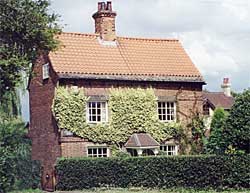
Church Cottage, Cossall, was the home of D H Lawrence's fiancee, Louise Burrows, and is depicted in his novel The Rainbow (photo: A Nicholson, 2004).
Richard Waplington, or "Dick Wap," as he was familiarly called, was born at Cossall in 1787. His school-days were spent with Shaw at Trowell Moor, and at the age of twelve or thirteen he went to work at the coal mines in the neighbourhood, in times when a miner's life was very different from what it is at the present day. At that time there was no steam machinery to do the heaviest part of the drudgery, and lads were kept at work from twelve to fifteen hours per day far down in the bowels of the earth; and at night, when tired and weary with the long day's toil, each lad had to carry home on his head, for household use, a lump of coal almost as much as he could stand under. But Dick was a strong, healthy lad, and seemed to thrive with his hard work—in fact, the constant physical energy required in his occupation developed his frame and muscles until he became one of the strongest men in the neighbourhood ; and when, in company with his old schoolmate Shaw, he enlisted into the Life Guards; at Nottingham Goose Fair, in 1807, he was over six feet in height, and stout in proportion. He visited Cossall two or three limes after his enlistment, and was there with Shaw in April, 1815, when they were ordered to join their regiment, and proceed to Belgium. Old Richard Buxton, of Cossall (who is now living in the hospital), says he well remembers seeing them during this last visit. They had been named in the regiment the "Cossall Giants," and two finer young fellows were never seen. Waplington's career at Waterloo seems not to have been so much noticed as Shaw's, but that he was equally brave may be gathered from the fact that one who know him well saw him, during the last charge at Waterloo, in possession of an eagle belonging to the French, and surrounded by a number of the Cuirassiers of the Guard, with whom be was engaged in desperate combat; and as he was never heard of afterwards, there is every reason to fear he fell a victim to overpowering numbers.
Thomas Wheatley was born at Cossall Marsh, in the year 1795, consequently was some years younger than Shaw and Waplington. He went to school at Cossall, in a room over the almshouses, until he was nine years of ago, when his father apprenticed him to a stocking weaver, and he followed his trade until there was a strike among the stockingers, in which he joined. During the strike his father dared not work in the daytime, for fear of the men on strike, but used to work at night to support his family. Thomas, thinking that kind of work would only prolong the strike, and no doubt led away, as young folks often are, by others, threatened to shoot his father if he did not give up the night work. But the worthy man and tender-hearted parent, not dreaming his son would go to such extremes, continued at work, until Thomas so far forgot himself as to fire at his father with a loaded pistol. The father fortunately moved his head at the moment, and the ball went through the window shutter, in which the hole remains to this day. As soon as the deed was done, and fearing the consequences, Thomas ran away from home and enlisted into the 23rd Light Dragoon Guards (since disbanded), in which he fought with distinction on the 17th June, 1815, at Genappes, and at Waterloo on the following day; and, unlike his friends, Shaw and Waplington, lived to return to his native village, in receipt of honours and a pension. He afterwards worked as hammerman at the blacksmith's forge, under the Babbington Colliery Company, for some years; and in 1832 distinguished himself as one of the Yeomanry Cavalry, in his defence of Wollaton Hall, when attacked by the mob who had destroyed Nottingham Castle and Beeston Mills. The last years of his life were spent in the almshouses at Cossall, and his ashes rest in the Churchyard of his native place.
For more than sixty years no stone or memorial of any kind told of the deeds of this noble trio; but in 1876 a movement was set on foot for the purpose of erecting a monument in the Churchyard. The efforts of the Committee were so far successful that the project was completed in the early part of the following year; and (as already mentioned) it was to celebrate this success that a holiday was "proclaimed" and strictly observed on "Waterloo Day," 1877. The monument stands near to the entrance gates of the Churchyard, and forms the object of interest to all who visit the village of Cossall. Its height is about twelve feet, and it is an obelisk, with carved foliage apex, a wreath of ivy leaves encircling the pyramid about half way down. It stands on a square base of stone, and is composed of pure white Carrara marble, in three heights. On the bottom one lie the cuirass, helmet, and two crossed swords of a Life Guardsman. The inscription is on the front side of the top square, which has been carved to represent a shield, and is as follows:—
WATERLOO.
This Monument is Erected to the Memory of JOHN SHAW
and
RICHARD WAPLINGTON, Of the Life Guards,
and THOMAS WHEATLEY,
Of the Light Dragoon Guards, Who left this their native home in defence of
their country.
The two former gloriously fell at Waterloo.
The latter returned and lies buried in this Churchyard.
VALOUR.
The sculptor was Mr. W. Jackson, of Nottingham, who executed his work in a most artistic manner. Amongst the subscribers towards the erection of the monument were H.R.H. the Duke of Cambridge, K.G., Earl Cowper, Earl Manvers, Lord Middleton, Col. Wilmot, V.C., M.P., F. C. Smith, Esq., M.P., T. W. Evans, Esq., M.P., and many others of the local gentry. The monument is one of which not only Cossall, but Nottinghamshire, may well be proud; and though it is a tribute to bravery which was long delayed, it is none the less, we are sure, an honest effort to commemorate the fame of the gallant heroes whose names are inscribed upon it.
The Fritchley family have resided at Cossall Marsh over two hundred years, and now occupy the only farm in the village that has not changed hands during the last twenty years. The late Richard Fritchley was a Captain in Lord Henry Middleton's Volunteers at the time of the battle of Waterloo. Richard and Charles Fritchley, his sons, have also served in the South Notts. Yeomanry Cavalry; and John James, his youngest son, has been a member of the same regiment for sixteen years, and is now the senior Sergeant of the Wollaton Troop. The last-named gentleman has been successful in carrying off several prizes, not only for his proficiency in sword exercise, but also as an excellent marksman. He was awarded the Captain's prize two years in succession, and failed by one point only to secure it a third year. He was also fortunate enough to obtain a regimental prize when he had been connected with the Yeomanry only six years.
On passing Cossall Marsh, the Great Northern Canal runs over an aqueduct, the only one to be seen in this neighbourhood. About the year 1823, the embankment close to this aqueduct gave way, and the water came down in torrents, completely flooding the low-lying houses in the immediate neighbourhood to a considerable depth, to the great alarm of their inmates.
On the 2nd of January, 1817, Daniel Diggle, a noted Luddite, in company with about eight others, while out on a poaching excursion near Trowell, wantonly beset the house of William Cook, of Shortwood, Lord Middleton's gamekeeper, and fired at him several times through his bed-room window. Diggle and several others, being arrested for this offence, began to impeach each other, and one of them was admitted as king's evidence, and ensured Diggle's conviction on a charge of shooting at a man named George Kerry (who had incurred the displeasure of the Luddites), at Radford, on the 22nd December, 1816. Diggle, who was only 21 years of age, was condemned to death, and executed in front of the County Gaol, Nottingham, on the 2nd of April following.
